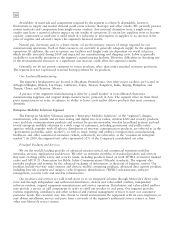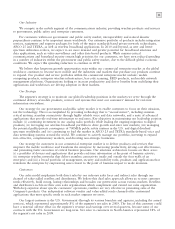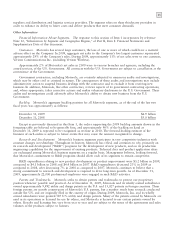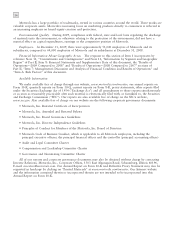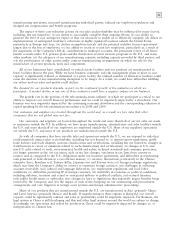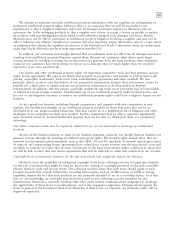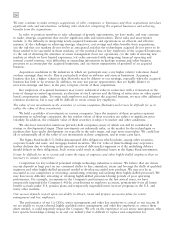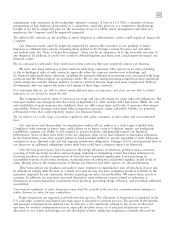Motorola 2009 Annual Report Download - page 26
Download and view the complete annual report
Please find page 26 of the 2009 Motorola annual report below. You can navigate through the pages in the report by either clicking on the pages listed below, or by using the keyword search tool below to find specific information within the annual report.
18
provide financing in connection with equipment purchases. In response to limited availability of financing
from banks and other lenders, these types of requests have increased in volume and scope. Motorola has
increased its commitments to provide financing in light of these requests and a continuation of the current
tightening in the credit markets could force Motorola to choose between further increasing its level of
vendor financing or potentially losing sales to these customers.
•Negative Impact from Increased Financial Pressures on Third-Party Dealers, Distributors and Retailers: A
number of our businesses make sales in certain regions through third-party dealers, distributors and
retailers. Although many of these third parties have significant operations and maintain access to available
credit, others are smaller and more likely to be impacted by the significant decrease in available credit that
resulted from the financial crisis. If credit pressures or other financial difficulties result in insolvency for
important third parties and Motorola is unable to successfully transition end-customers to purchase our
products from other third parties or from us directly, it may cause, and in some cases has caused, a
negative impact our financial results.
•Negative Impact from Increased Financial Pressures on Key Suppliers: Our ability to meet customers’
demands depends, in part, on our ability to obtain timely and adequate delivery of quality materials, parts
and components from our suppliers. Certain of our components are available only from a single source or
limited sources. If certain key suppliers were to become capacity constrained or insolvent as a result of
global economic conditions, it could result in a reduction or interruption in supplies or an increase in the
price of supplies and negatively impact our financial results. In addition, credit constraints at key suppliers
have resulted in accelerated payment of accounts payable by Motorola, impacting our cash flow. If this
trend continues, it will negatively impact our cash flow.
•Increased Risk of Losses or Impairment Charges Related to Debt Securities and Equity and Other
Investments Held by Motorola: The current volatility in the financial markets and overall economic
uncertainty increases the risk that the actual amounts realized in the future on our debt and equity
investments, including those held in the Sigma Fund, will differ significantly from the fair values currently
assigned to them.
Also, many of the Company’s equity investments are in early-stage technology companies and, therefore,
may be particularly subject to substantial price volatility and heightened risk from the tightening in the
credit markets.
•Increased Risk of Financial Counterparty Failures Could Negatively Impact our Financial Position: The
Company uses derivative financial instruments to reduce its overall exposure to the effects of currency
fluctuations on cash flows. The Company is exposed to credit loss in the event of nonperformance by the
counterparties to these derivative financial instruments. In order to minimize this risk, the contracts are
distributed among several leading financial institutions, all of whom presently have investment grade credit
ratings. Although the Company has not experienced and does not anticipate nonperformance by its
counterparties, in light of the ongoing threats to financial institutions from global economic conditions,
there can be no assurance of performance by the counterparties to these financial instruments.
•Returns on Pension and Retirement Plan Assets and Interest Rate Changes Could Affect Our Earnings in
Future Periods: The funding position of our pension plans is impacted by the performance of the financial
markets, particularly the equity markets, and the discount rates used to calculate our pension obligations
for funding and expense purposes. Although there was some recovery in value during 2009, significant
declines in the financial markets in 2008 negatively impacted the value of the assets in the Company’s
pension plans. In addition, lower bond yields may reduce our discount rates resulting in increased pension
contributions and expense.
Funding obligations are determined under government regulations and are measured each year based on
the value of assets and liabilities on a specific date. If the financial markets do not provide the long-term
returns that are expected under the governmental funding calculations, we could be required to make
larger contributions. The equity markets can be, and recently have been, very volatile, and therefore our
estimate of future contribution requirements can change dramatically in relatively short periods of time.
Similarly, changes in interest rates can impact our contribution requirements. In a low interest rate
environment, the likelihood of higher contributions in the future increases.
•Impact on Ability to Sell Receivables: The Company sells accounts receivable and long-term receivables to
third parties. Sales are made both on a one-time, non-recourse basis and under committed facilities that
involve contractual commitments from third parties to purchase qualifying receivables up to monetary




